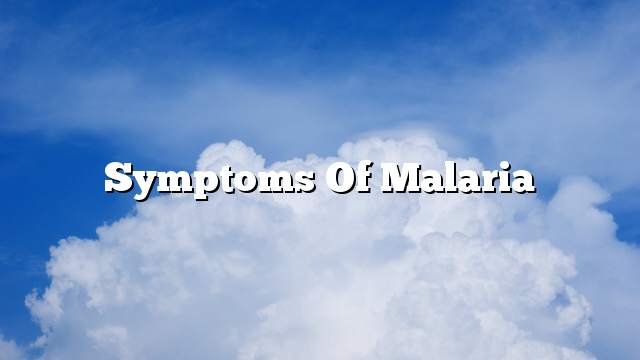The disease is divided in terms of symptoms and signs to:
1. Malignant or dangerous disease caused by plasmodium falcipurum
2 – the benign disease caused by the rest of the species
Serious illness
The symptoms of the disease gradually begin to be flu symptoms such as feeling tired and tired, headache, vomiting, diarrhea, cough and slight rise in temperature
The person has symptoms and signs of red blood cells
1 – high temperature associated with the feeling of trembling with severe sweating, nausea and vomiting
2 – yellowing and signs of anemia (general weakness, jaundice, headaches and sometimes loss of consciousness)
3 – enlargement of the liver and spleen
The disease is accompanied by many serious complications:
1 – Malaria coma (cerebral malaria)
2 – convulsions
3 – severe anemia
4 – acute deficit in the liver and kidneys
Frequent bleeding
6. Hypoglycemia and blood acidity
Benign disease
The symptoms and signs of this disease in the first stage are similar to the signs and symptoms of the malignant disease at the beginning, and the symptoms and signs of the explosion of red blood cells are less dangerous than the malignant disease
With no serious contagion in this disease.
The symptoms of malaria appear only after 8 to 10 days after the blast of red blood cells from the attack of the parasite causing malaria.
– Feeling tired and persistent nausea symptoms of malaria
Malaria patients have severe abdominal pain
Headache and severe pain in the head
Severe pain spreads in the body parts of the malaria patient
_ The incidence of severe fever and high temperature rise
– severe chills with a strong desire to vomit
Extreme sweating
Very yellowing
_ Injuries strong convulsions
Infection of brain or cerebral malaria
_ Great pains in the digestive system and stomach
Infection and rupture of red blood cells
1. Malaria is a common disease in tropical countries and is one of the leading causes of death in these areas.
2. The disease is caused by a parasite called plasmodium and needs an intermediary, a female Anopheles mosquito.
3 – Symptoms and signs of the disease is high fever and yellowing in the body and symptoms of anemia due to red blood cells explosion.
4 – Diagnosis of the disease after suspicion of the disease is by a picture of the blood of the patient.
5 – Prevention is better than treatment and is done by avoiding mosquitoes and drug prevention.
6 – treatment of the disease includes treatment for symptoms and signs and treatment against parasite
7. Misuse of anti-malarial drugs has led to increased host resistance
And thus to the increased risk of disease and deaths.
Oxford handbook of clinical medicine 8th edition
Dvidson’s principles and practice of medicine 21st edition
infoplease.com/cig/dangerous-diseases-epidemics/malaria.html
